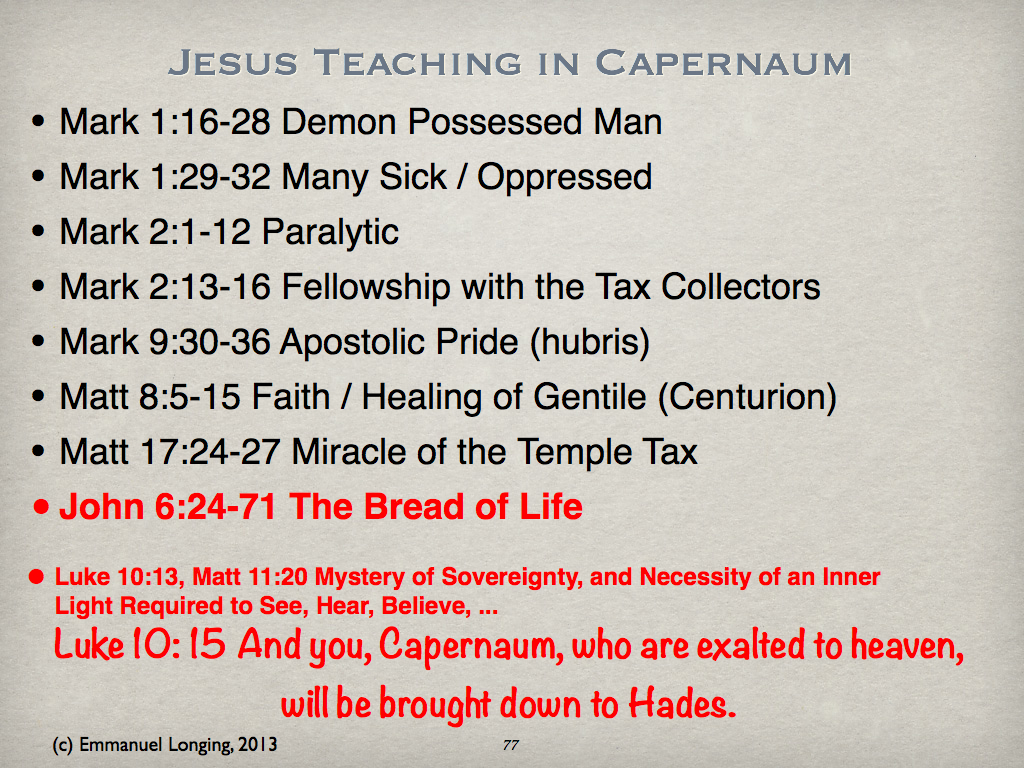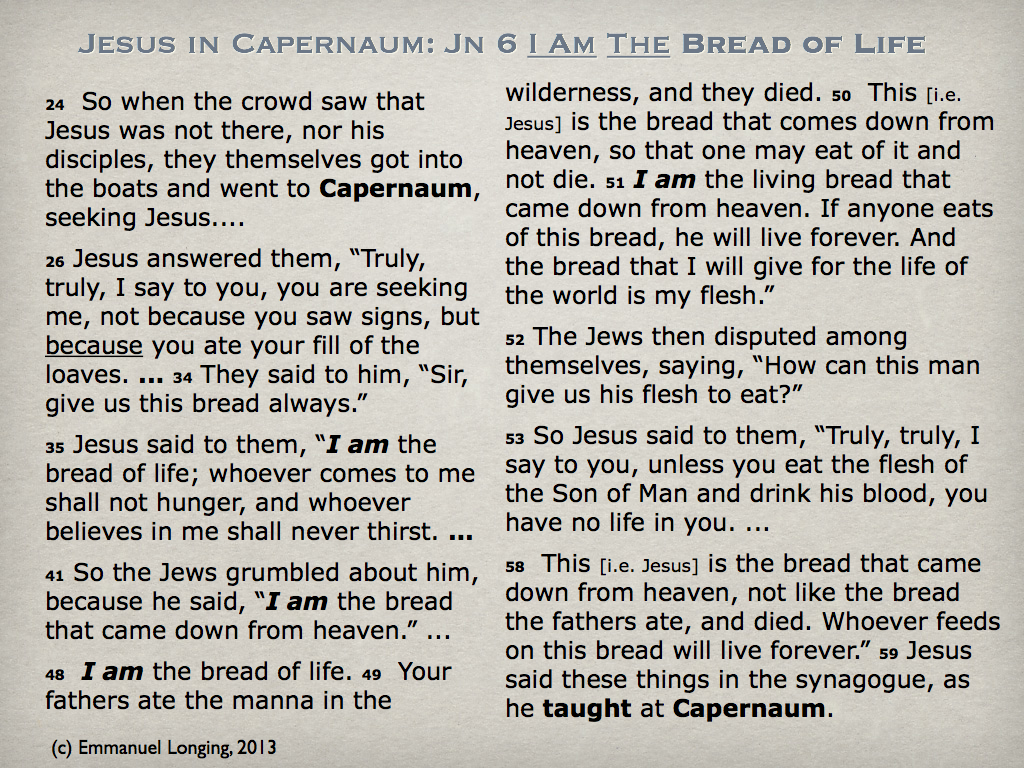Below is a summary of key events in the life or Christ that occurred in Capernaum. There were notable miracles done. But far more notable was Jesus’s teaching of the meaning behind the signs of the miracles.  Before He healed the man bound by paralysis of both legs, He announced to that man, and to the entire Synagogue, that He had forgiven the man his sins. This was of course shocking because the sins in question were not offenses against a person, such as a dispute between neighbors, but the offenses before and against a Holy and Righteous God which only God Himself could forgive, and only did so, in a symbolic way in Jerusalem through the sacrificial system mediated by Levitical priests. Then to show that Jesus has such authority to forgive–because in fact all the sins of all men were against the Person who Jesus would ultimately disclose Himself to be–Jesus then performed the smaller but in human eyes more dramatic miracle of healing the completely shriveled and dysfunctional legs of the man.
Before He healed the man bound by paralysis of both legs, He announced to that man, and to the entire Synagogue, that He had forgiven the man his sins. This was of course shocking because the sins in question were not offenses against a person, such as a dispute between neighbors, but the offenses before and against a Holy and Righteous God which only God Himself could forgive, and only did so, in a symbolic way in Jerusalem through the sacrificial system mediated by Levitical priests. Then to show that Jesus has such authority to forgive–because in fact all the sins of all men were against the Person who Jesus would ultimately disclose Himself to be–Jesus then performed the smaller but in human eyes more dramatic miracle of healing the completely shriveled and dysfunctional legs of the man.
Again we have layers of meaning. Man in his sins is utterly incapable of having any ‘walk’ before God. He lives a certain kind of death, though he is alive. Jesus healed the man in both his spiritual and physical dimensions, in both cases without any expression of repentance or sacrifice recorded. Both healings, the physical and the spiritual, were manifestations of God’s Grace.
If we now turn to the referenced passage in the Gospel of John we will see Jesus declaring Himself before the people in the small Jewish, fishing village, that He, Jesus, was and is the very sustenance of life (bread) as the manna was that fell faithfully overnight each night during Israel’s wilderness wanderings after Exodus during that 40 year period before the people under Joshua took occupancy of the Land.
 Regarding the above passage, note the immediate distinction between seeing “signs” and satisfying hunger with (free!) bread. One of the enduring questions about the historical life of Jesus is, “Why not more miracles, so many miracles that anyone’s brain that was committed to disbelieve would, like, explode?” An obvious answer is that Jesus performed many miracles, plenty to give evidence of His Being; but for one committed to doubt, i.e. one not enabled to believe, no number of miracles would have been, or be now, enough. Another answer is that our fallen hearts are naturally attracted to the glamour of the miracle and in particular to ‘what it did for me’ (as in free food, plenty of wine, curing my bursitis, whatever; the list is always endless). But the most important answer is that the continuing miracle, in a very real sense of the word, is the signs associated with Jesus Words, whether they be in the context of explaining a miracle, as with the paralytic man, or as in the above text explaining that miracle of the bread was a picture of Jesus as the manna of God sustaining His people in the wilderness. This latter point leads to the very deep idea connected with the “I Am” highlighted in the passage (four times).
Regarding the above passage, note the immediate distinction between seeing “signs” and satisfying hunger with (free!) bread. One of the enduring questions about the historical life of Jesus is, “Why not more miracles, so many miracles that anyone’s brain that was committed to disbelieve would, like, explode?” An obvious answer is that Jesus performed many miracles, plenty to give evidence of His Being; but for one committed to doubt, i.e. one not enabled to believe, no number of miracles would have been, or be now, enough. Another answer is that our fallen hearts are naturally attracted to the glamour of the miracle and in particular to ‘what it did for me’ (as in free food, plenty of wine, curing my bursitis, whatever; the list is always endless). But the most important answer is that the continuing miracle, in a very real sense of the word, is the signs associated with Jesus Words, whether they be in the context of explaining a miracle, as with the paralytic man, or as in the above text explaining that miracle of the bread was a picture of Jesus as the manna of God sustaining His people in the wilderness. This latter point leads to the very deep idea connected with the “I Am” highlighted in the passage (four times).
In the Greek the phrase “I am” is a doubled emphasis on the word “I.” “I” means, simply, me, but more meaningfully that I exist (“be”). The Greek word “eimi” (a form of “to be”) means all by itself, “I am.” But the phrase in the above text is “Ego eimi” (“Ego” means “I”). So the phrase carries an emphasis on both Jesus as a Being and Being itself. We know from the opening verses in the Gospel of John that Jesus is the uncreated Creator of all things:
John 1:1 “In the beginning was the Word, and the Word was with God, and the Word was God.2 He was in the beginning with God. 3 All things were made through Him, and without Him nothing was made that was made. 4 In Him was life, and the life was the light of men. 5 And the light shines in the darkness, and the darkness did not comprehend it.” (NKJV)
Later in John 1 we are clearly taught that “the Word became flesh and dwelt among us” means that the “Word” (Greek “logos”) refers to Jesus as the communicator / revealer of God and that which is otherwise inaccessible to us bound as we are in space-time.
Further this Greek phrase “Ego eimi” is exactly the phrase in the Septuagint (LXX, the ancient translation of the Old Testament from Hebrew to Greek) in the passage Exodus 3:14 where God answers Moses’s question about who should Moses say sent him to deliver God’s people out slavery in Egypt. The text tells us that God told Moses to tell His people that the “Ego eimi” sent you. (This phrase is so freighted with meaning that it defeats any simple attempt at translation. Most translations attempt it by using “I AM that I AM.”) So Jesus’s claim about His Being in the above passage from John 6 is also a reference back to the very claim of God as to describing His essential nature. So Jesus is making the claim that not only was the miracle of the bread about bread, but a sing, and not only is Jesus Himself the essential food of our deepest life, but in addition Jesus is God.
Further, in Exodus 3:15, the text links the Tetragrammaton, YHWH (Greek, “Kurios;” English, “Lord”), to “God” (Greek, “Theos,” which is the root of our English word “Theology,” the study of God):
Ex 3:15 Moreover God said to Moses, “Thus you shall say to the children of Israel: ‘The Lord God [Hebrew, “YHWH Elohim;” LXX Greek, “Kurios Theos”] of your fathers, the God of Abraham, the God of Isaac, and the God of Jacob, has sent me to you. This is My name forever, and this is My memorial to all generations.’ (NKJV).
Referring to Jesus as “Lord Jesus” or simply “Lord” or “The Lord” is another direct reference to these two significant verses in Exodus Chapter 3.
We have previously considered how pride (hubris), is closely connected to deceit (as in being deceived) and even to blindness. The ministry of John the Baptist served to identify Jesus as the Lamb of God, as we have seen previously. But John’s ministry to the people was to offer baptism as an outward symbol of repentance. Those who came to John to express repentance were publicly acknowledging that “Law” as an operating principle was not making them righteous, but only making clear their guilt before God. Of course those who had faith in their standing before God because of (1) their zeal for the Law (the Pharisees), or (2) their wisdom and general moral good works (the Sadducees), saw no need for John’s baptism, or for repentance.
In the Capernaum events and messages, there were several ‘trigger points’ with respect to the Pharisees. One was Jesus’s claim of His power to forgive sins. Another, and this one recurs through many of Jesus’s miracles, was Sabbath keeping. Jesus purposefully performed healings on the Sabbath because, like John’s baptism, such event created a great divide. Those who saw the absolute rigid need to ‘keep’ the Sabbath, as men were commanded to do under the Old Covenant, were offended at anyone doing anything that had an appearance of “work.” However, the Sabbath was a teaching by God of His people to rest, portraying the need of recognizing that self-effort can never carry one to some state of righteousness before God. Rigid law-keeping of the Sabbath actually had the opposite effect: the Pharisees believed that such behavior both demonstrated and earned their own righteousness. But, even more importantly, Jesus made a claim of authority over the Sabbath itself.
Let us now turn to proper heart response to life under Law by considering the famous Sermon on the Mount. The idea of a “mount” is a type of parallel to the Temple Mount, but the famous Sermon took place on a very different mount: on the shores of the Sea of Galilee far north of Jerusalem, and away from any Temple, or even any building. The Sermon took place on a grassy hillside with the only Temple being the the very Lord Jesus Christ giving the message.